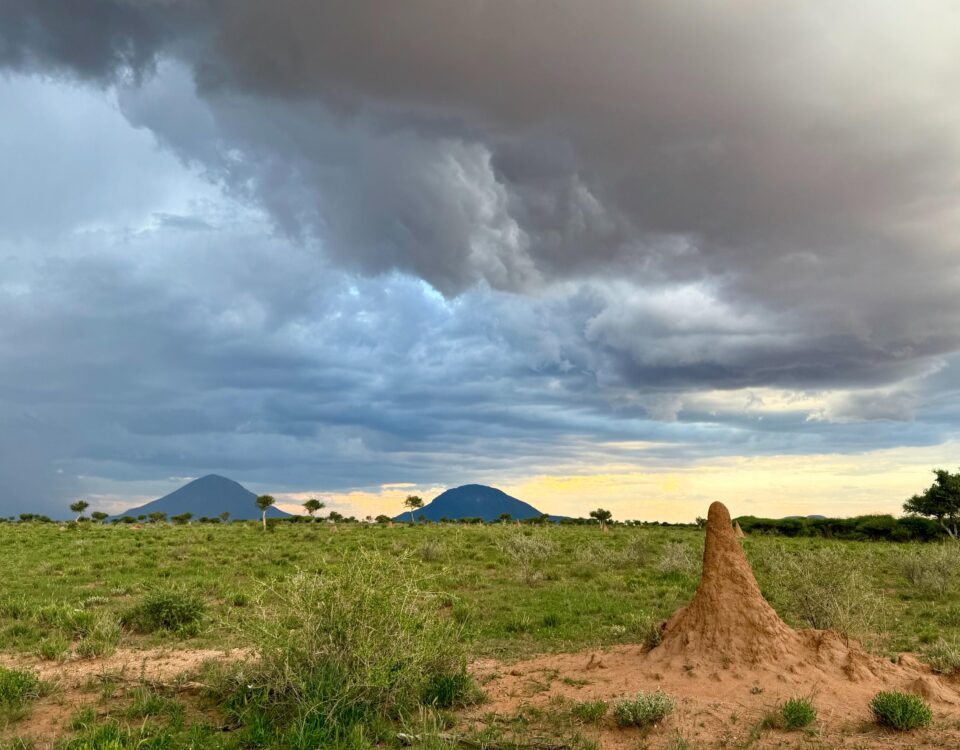Classical pianist Alexis Golovin in concert
August 6, 2012Building together day by day
August 6, 2012Text and photos by ©Sharri Whiting De Masi – All photographs copyright of the author
Re-printed with permission of the author
Travellers to Namibia come expecting endless stretches of desert, soaring red dunes, and sunny day after sunny day. This is the spectacular view of Namibia that is most familiar around the world, and sun-hungry visitors from other climes arrive here eager for dry, cloudless, sun-baked landscapes.
But… what if you arrive and it’s raining? Depending on the year and earth’s climate conditions, Namibia’s normal summer rainy seasons may have continued into the autumn (April or May) or started early (October or November). Is your vacation ruined? Absolutely not!
For one thing, it rarely rains all day – usually showers are brief and the skies soon clear again. What you will find is a miraculous transformation of the desert, where silvery grasses shimmer and sway, revealing the red or opalescent sands beneath, and sharp-edged mountains softened by the fresh green of new vegetation, a pleasing sight to both animals and humans.
If you’re lucky, you’ll see the vast salt pan in the Etosha National Park become an enormous shallow sea, where pelicans and flamingos sail and the sunsets are dramatic in a whole new way. Or you could be fortunate enough to find yourself in Namibia’s south during the rains, when geophytes – ‘desert lilies’ that have remained inactive underground for years – burst into bloom in normally arid desert pans, turning them into fields of flowers. Normally dry rivers run, often for the first time in years; on rare occasions, the dry Swakop River metamorphoses into a rushing watercourse that reaches the Atlantic Ocean at Swakopmund, drawing onlookers from all over the country.
For Namibians who have experienced some of the worst droughts ever, rain is a gift from Mother Nature that is not to be taken lightly. Crops will grow, animals will drink, farmers will prosper. The air will be cool, there will be shady trees to sit under and time for dolce far niente (Italian for ‘the sweetness of doing nothing’). Everyone will be in a good mood.
Visiting Namibia is a delightful adventure and the best adventures invariably come with surprises – welcome them and enjoy your vacation
Namibia’s excellent roads, however, were not built for extended rainy seasons, so water may turn up in the most expected places. Rainfall from higher elevations rushes downhill toward the sea, bringing debris with it. While the locals are happy to pull tourists out of the mud with their tractors or trucks, they know that taking chances with running water can be dangerous.
Pointers for driving in a wet Namibia:
- Consider renting a four-wheel drive vehicle, but make sure beforehand how to handle it. Practise driving in town so that you are comfortable with the centre of gravity of the vehicle. The height of an all-terrain vehicle can be helpful when crossing puddles or mud.
- Don’t take chances. Water running across a road could obscure a deep dip, so much so that your vehicle could be washed away. Likewise a ‘puddle’ could be hiding a deep hole, which could damage your car.
- Don’t cross water that’s running across a road unless you are a very experienced driver and you have seen others crossing safely. Watch carefully to see the depth and speed of the water, and don’t attempt it if you’re driving in a remote area. And don’t walk into the water to check the depth – you might be hit by a floating tree or other debris. Strong waters can turn your car over and wash it downstream. The water will subside after a while, so take a break with a cup of coffee, or have a picnic while you wait.
- Drive slowly. Stop and ask at lodges or gas stations about the conditions ahead.
- Don’t drive in the dark.
- Don’t park in riverbeds, as unexpected surges of water could take you unawares.
- Be flexible. Some of your plans may have to be changed, as water may block roads or even damage lodges or camps you may want to visit.
Keep in mind that visiting Namibia is a delightful adventure and that the best adventures invariably come with surprises – welcome them and enjoy your vacation.
This article appeared in the January Edition of FLAMINGO Magazine.

